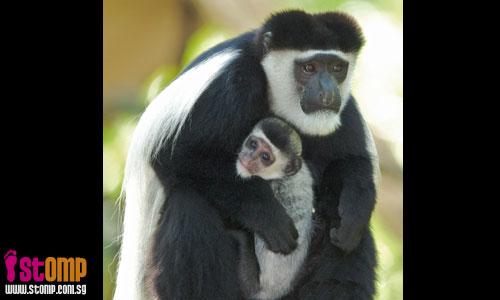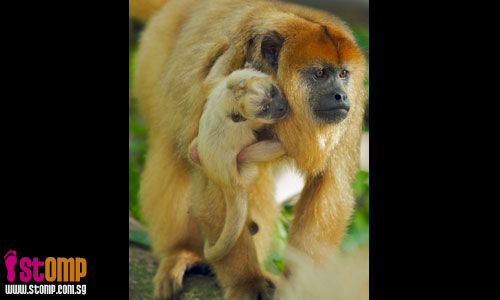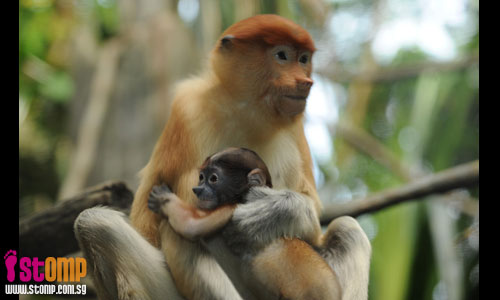
In its press release to STOMP today (Mar 10), the Singapore Zoo proudly announced the birth of the colobus monkey, the first after a long hiatus of 12 years. This brings its total number of recent monkey births to four - one colobus, one howler and two proboscis monkeys.
Appended is their statement:
"There is now new meaning to the cheeky phrase 'monkeying around'.
"Primates at Singapore Zoo certainly have been doing a lot of that with four recent births; one each of the colobus and black howler monkeys and two proboscis monkeys.
"These births mark the first for the colobus after a hiatus of about 12 years, fifth for the black howler, and sixteenth and seventeenth for the proboscis monkey.
"The Singapore Zoo strives to provide an optimal environment for endangered and sensitive species like the proboscis monkeys.
"Forest-dwelling primates the world over continue to face tremendous pressures that threaten their existence, ranging from habitat destruction to poaching for bushmeat.
"'We are committed to preserving such endangered primates, and will carry on with the breeding, conservation and research efforts to ensure that populations continue to thrive', said Mr Biswajit Guha, Assistant Director, Zoology, Singapore Zoo."

Photos of Colobus Monkey and Howler Monkey courtesy of Mr Bjorn Olesen

Photo of Proboscis Monkey courtesy of Wildlife Reserves Singapore
I haven't visited the Singapore Zoo for far too long. It's great to hear of these births, especially since captive breeding is often a sign that the animals are doing relatively well. Of course, that isn't necessarily the case, but being able to breed animals, especially rare and endangered species, is one of the benchmarks by which zoos measure and compare their success.
The Eastern black-and-white colobus (Colobus guereza) of the forests of Central and East Africa, and the black howler monkey (Alouatta caraya) of forests and woodlands south of the Amazon Basin, are currently listed as species of 'Least Concern', although both species are experiencing population declines, while the proboscis monkey (Nasalis larvatus), restricted to riverine and coastal forests of Borneo is considered to be 'Endangered', and it too is experiencing a decreasing population.
Indeed, primates as a whole seem to be in great trouble; the World Conservation Union (IUCN) reported in 2008 that out of 634 primates, nearly half of the species and subspecies are endangered. The situation in Asia is especially dire, with more than 70 percent of the continent's primates listed as 'Vulnerable', 'Endangered', or 'Critically Endangered'. Hunting (for meat, the exotic pet trade, and traditional medicine) and habitat destruction are the main threats faced by virtually all primate species.
25 Most Endangered Primates Named
Even our closest living relatives, the great apes, are facing considerable pressure; clearing of the rainforests of Sumatra and Borneo for logging and plantations is accelerating the decline of the Sumatran orangutan (Pongo abelii) and Bornean orangutan (Pongo pygmaeus), while in Africa, hunting for bushmeat, deforestation and diseases like Ebola are ravaging populations of western gorilla (Gorilla gorilla), eastern gorilla (Gorilla beringei), chimpanzee (Pan troglodytes) and bonobo (Pan paniscus). Civil war is another threat faced by several populations of African apes; several mountain gorillas (Gorilla beringei beringei) living in the Democratic Republic of the Congo were murdered in 2007, pawns in a deadly power struggle between various warring factions.
2009 happens to be the Year of the Gorilla, and I think this in a way symbolises the grim future of many primate species. If we ever callously allow our closest living relatives to vanish into oblivion, what hope do we have for the multitude of other more distantly related primate species, such as monkeys to tarsiers, loris, and lemurs?
The Singapore Zoo does not possess any gorillas, since they are highly susceptible to the common Asian bacterium Pseudomonas psuedomallei, and past attempts have had tragic results; five of six gorillas sent to Singapore from European zoos eventually succumbed to melioidosis, or 'soil disease'. Still, I am interested in seeing if the Singapore Zoo has any programs lined up in conjunction with the Year of the Gorilla.
Despite the lack of gorillas, the zoo does have quite an impressive primate collection, and over the years, I have been greatly impressed at the great diversity of primate species from all over the world that were on display. It is notable for its great success in breeding both species of orangutan, and outside of Indonesia, has had the most success in captive breeding of proboscis monkeys. According to the 2007/2008 yearbook, other recent primate births have also included ring-tailed lemur (Lemur catta), black-tufted marmoset (Callithrix penicillata), red-handed tamarin (Saguinus midas), cotton-top tamarin (Saguinus oedipus), brown-headed spider monkey (Ateles fusciceps), white-faced saki (Pithecia pithecia), lion-tailed macaque (Macaca silenus), Hamadryas baboon (Papio hamadryas), Javan langur (Trachypithecus auratus), silver langur (Trachypithecus cristatus), and chimpanzee. Besides the births, other new arrivals include a pair of buff-cheeked gibbon (Nomascus gabriellae), which the zoo acquired in the hopes of eventually breeding them. It also obtained a male purple-faced langur (Trachypithecus vetulus) from Edinburgh Zoo, and it is hoped that it will pair up with the Singapore Zoo's single female specimen, and help boost the captive population of this species. In the meantime, some black howler monkeys, silver langurs, and chimpanzees were sent to other zoos to facilitate the captive breeding programs there.
The importance of captive breeding in conservation is subject to much debate; it cannot be denied that in-situ conservation, ensuring that species are not wiped out from their native range, is the most vital piece of the puzzle. In this context, captive breeding is only a stopgap measure just in case some calamity befalls the wild population, or to build up a sizeable population that can be then reintroduced into the wild. Ideally, captive breeding should occur in conjunction with well-planned programs for eventual reintroduction. But at the same time, captive breeding does relieve some of the pressure on wild populations, ensuring that the captive population does not die out anytime soon. The concept of keeping and displaying wild animals in captivity is not going to go away anytime soon, and many zoological institutions do carry out a great deal of contribution to in-situ conservation work, but I would say that this is ultimately the most important function of captive breeding.
Perhaps I'll pop by the Singapore Zoo during the holidays.